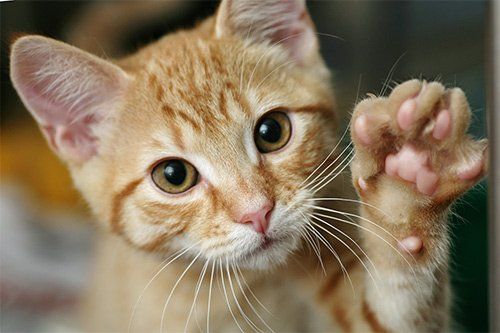If you are considering having your cat declawed, here is some valuable information that might change your mind. In this article you will learn exactly what declawing is and the physical and behavioral issues that can result, as well as humane alternatives that have been proven to work!
- According to a study published in the Journal of Feline Medicine and Surgery, declawed cats are 7 times more likely to pee in inappropriate places, 3 times more likely to show aggression and approximately 30% develop over-grooming behavior.
- It’s interesting to note that declawing is pretty much an American thing. It is banned in most European countries as being an “inhumane and unnecessary mutilation.” In 2019, New York was the first U.S. state to ban declawing, and others are expected to follow suit.
So why are so many places banning it? Let’s discuss what declawing actually is.
WHAT IS DECLAWING? Well, it’s not a day at the spa as far as your cat is concerned. Some pet owners think of declawing as a “mani-pedi” for cats, but it’s not.
- Unlike human nails, a cat’s claws are attached to bone. Declawing is a surgical procedure that slices through tendons and nerves to remove the last segment of bone in each toe. If this same surgery was performed on a human being, it would be like cutting off each finger at the last knuckle.
- Declawing involves painful surgery and a painful recovery process. While recuperating, your cat still has to walk and scratch in the litter box, even though these simple activities cause extreme pain.
- Declawing leaves your cat defenseless outside. At some point in their lives, many cats will run outside through a door accidentally left open. A declawed cat is defenseless if attacked by another animal and is unable to climb a tree to escape.
PHYSICAL RESULTS OF DECLAWING:
- Permanent pain and discomfort in the paws (nails may grow back inside), causing many cats to develop the habit of chewing on the stubs.
- Life-threatening infections
- Tissue necrosis (tissue death)
- Bone spurs
- Permanent nerve damage
- Lameness and difficulty walking. Because declawing permanently deforms a cat’s foot, he is forced to change the way he walks and has to support himself on the soft cartilage that was formerly part of the joint.
- Declawed cats are also 3 times more likely to develop permanent back pain and arthritis because of this unnatural way of walking.
BEHAVIORAL RESULTS OF DECLAWING:
It’s not uncommon for cats to develop new behavioral problems after declawing and there are many studies documenting these changes:
- Litter box problems: According to the Journal of Feline Medicine and Surgery, declawed cats are 7 times more likely to pee in inappropriate places. Cat owners are usually advised to use shredded newspaper for several days following surgery so that ordinary litter does not get into or irritate the paws. However, because this substance is unfamiliar to the cat and because scratching in the pan will likely cause pain, many cats will begin to avoid using the litter box. They are more likely to urinate on soft surfaces like carpets, furniture or clothing because it’s less painful than the hard litter in the litterbox.
- Aggression: That same study showed that declawed cats exhibit 3 times more overall aggression than cats that are not. Cats have no way of communicating that they are in pain and will “act out” or become more aggressive because of this. They may resort to biting when their owner tries to pick them up or even touch them.
- Overgrooming: Cats are among the most fastidious of creatures and normally spend at least 1/4 of their waking hours tending to their fur. However, declawing can create a psychological issue in your cat which results in over-grooming. This can create additional pain or discomfort and lead to skin infections involving the abdomen, legs, flanks, chest and other easily reached areas of the body. Approximately 30% of declawed cats develop this habit, which can result in bald patches, rashes and scabs.
HUMANE SOLUTIONS TO DECLAWING:
This may have convinced you that declawing is a painful and drastic step to take, but you may be left wondering how to better protect your household furniture and furnishings, not to mention your own skin. We’re happy to report that there are acceptable and yet effective solutions to these issues, without causing a lifetime of pain to your feline. Read further to find out what will work best.
- Scratching posts: These satisfy your cat’s natural instinct to sharpen its claws. Provide two or more stable scratching posts and boards around your home. Offer different materials like sisal, carpet, wood, and cardboard and well as different styles (vertical or horizontal). Use catnip or toys to entice them. Show your cat, by engaging in fun activities at the post, that this is the correct place to scratch. For more info on how to get your cat to scratch where he is supposed to, click here
- Nail covers: These are lightweight vinyl caps that are affixed to your cat’s front claws with a special glue-like adhesive. They are easy to apply, last for about 4 to 6 weeks and are an inexpensive solution. They usually come in sets of 40 (which would cover 4 applications) and are available for under $15.00. They are available in clear or a variety of colored caps which will make your cat look like it really did spend a day at the spa! These are not recommended for outdoor cats.
- Nail trimming: Cutting your cat’s nails on a regular basis ismuch easier than you think! I always show my new cat adopters how to take care of this important step, especially in a kitten’s first year of life when they are the most active and learning where they should and shouldn’t exercise their scratching urges. Set your phone to remind you every 2 weeks and you can use regular human nail clippers! There are numerous videos on YouTube to walk you through the process. For more info and step-by-step instructions, click here
In summary: Now that you know the facts about declawing and the easy alternatives, we are sure you will no longer consider this painful and inhumane surgical procedure. Your cat will definitely thank you.

